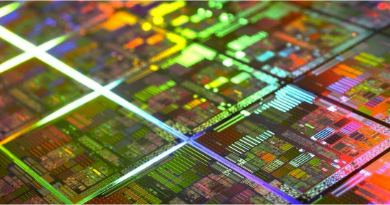Blue phosphorus: How a semiconductor becomes a metal – Phys.org
Click here to sign in with or
Forget Password?
Learn more
share this!
15
8
Share
Email
November 5, 2020
by Dresden University of Technology
The chemical element phosphorus is considered one of the most essential elements for life. Phosphorus compounds are deeply involved in the structure and function of organisms. Every human carries about one kilogram of it in the body. But even outside our bodies we are surrounded by phosphates and phosphonates every day: in our food, in detergents, fertilizers or in medicines.
Phosphorus occurs in several modifications that have extremely different properties. Under normal conditions, a distinction is made between white, purple, red and black phosphorus. In 2014, a team from Michigan State University, computationally predicted “blue phosphorus,” which could be produced experimentally two years later.
Blue phosphorus is a so-called two-dimensional (2-D) material. Due to its single-layer honeycomb-like structure, it is reminiscent of what is probably the best known 2-D material: graphene. Analogous to its famous forerunner, it was then also called blue phosphorene. This novel semiconductor material has since been investigated as an extremely promising candidate for optoelectronic devices.
The Dresden chemist Prof Thomas Heine, in cooperation with Mexican scientists, has now made a unique discovery: by applying a topological concept they identified computationally a remarkably stable two-layer buckled honeycomb structure of blue phosphorene by means of highly precise calculations on high-performance computers. This two-layered compound is extremely stable. As the scientists surprisingly discovered, it has metallic properties due to the very small distance between the two layers. The results of these investigations were published as a highlight article in the current issue of the journal Physical Review Letters.
Like all components, these devices must be supplied with power, which usually enters the material via metal electrodes. At the metal-semiconductor interface, energy losses are inevitable, an effect known as the Schottky barrier. Blue phosphorus is semiconducting as a single layer, but predicted to be metallic as a double layer. Metallic 2-D materials are very rare, and for the first time a pure elemental material has been discovered that exhibits a semiconductor-metal transition from the monolayer to the double layer. Thus, an electronic or optoelectronic component for use in transistors or photocells can be realized from only one chemical element. Since there is no interface between semiconductor and metal in these devices, the Schottky barrier is greatly reduced and a higher efficiency can be expected.
“Imagine you put two layers of paper on top of each other and suddenly the double sheet shines metallically like gold foil. This is exactly what we predict for blue phosphorene. This work underlines the importance of interdisciplinarity in basic research. Using a topological-mathematical model and theoretical chemistry, we were able to design a new material on the computer and predict its physical properties. Applications in the field of nano- and optoelectronics are expected,” explains Prof Heine.
For these promising results in basic research, first author Jessica Arcudia from Mexico has already been awarded the LatinXChem poster prize and the ACS Presidential Award. The young chemist was a guest student in the research group of Thomas Heine in 2018, where her doctoral supervisor Prof Gabriel Merino had also worked before.
More information: Jessica Arcudia et al, Blue Phosphorene Bilayer is a Two-Dimensional Metal and an Unambiguous Classification Scheme for Buckled Hexagonal Bilayers, Physical Review Letters (2020). DOI: 10.1103/PhysRevLett.125.196401
Journal information: Physical Review Letters
Provided by Dresden University of Technology
More information: Jessica Arcudia et al, Blue Phosphorene Bilayer is a Two-Dimensional Metal and an Unambiguous Classification Scheme for Buckled Hexagonal Bilayers, Physical Review Letters (2020). DOI: 10.1103/PhysRevLett.125.196401
Journal information: Physical Review Letters
Journal information: Physical Review Letters
Provided by Dresden University of Technology
Explore further
Facebook
Twitter
Email
Feedback to editors
15 hours ago
1
16 hours ago
1
18 hours ago
0
May 25, 2024
1
May 24, 2024
1
3 hours ago
12 hours ago
12 hours ago
14 hours ago
14 hours ago
15 hours ago
15 hours ago
15 hours ago
16 hours ago
16 hours ago
May 25, 2024
May 24, 2024
May 22, 2024
May 14, 2024
May 11, 2024
May 10, 2024
More from Atomic and Condensed Matter
Apr 27, 2020
Oct 16, 2018
Mar 31, 2020
Jun 16, 2020
Aug 18, 2020
Apr 12, 2017
18 hours ago
18 hours ago
May 25, 2024
May 24, 2024
May 23, 2024
May 23, 2024
Use this form if you have come across a typo, inaccuracy or would like to send an edit request for the content on this page. For general inquiries, please use our contact form. For general feedback, use the public comments section below (please adhere to guidelines).
Please select the most appropriate category to facilitate processing of your request
Thank you for taking time to provide your feedback to the editors.
Your feedback is important to us. However, we do not guarantee individual replies due to the high volume of messages.
Your email address is used only to let the recipient know who sent the email. Neither your address nor the recipient’s address will be used for any other purpose. The information you enter will appear in your e-mail message and is not retained by Phys.org in any form.
Get weekly and/or daily updates delivered to your inbox. You can unsubscribe at any time and we’ll never share your details to third parties.
More information Privacy policy
We keep our content available to everyone. Consider supporting Science X’s mission by getting a premium account.
Medical research advances and health news
The latest engineering, electronics and technology advances
The most comprehensive sci-tech news coverage on the web


